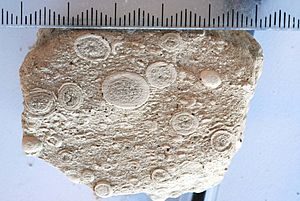Oruanui eruption facts for kids
Quick facts for kids Oruanui eruption |
|
|---|---|

A large eruption column during the Oruanui eruption as it may have appeared from space
|
|
| Volcano | Taupo Volcano |
| Date | About 26,500 BC |
| Type | Ultra-Plinian |
| Location | North Island, New Zealand 38°48′S 175°54′E / 38.800°S 175.900°E |
| VEI | 8 |
The Oruanui eruption was a massive volcanic explosion from New Zealand's Taupo Volcano. It happened around 26,500 BC. This eruption was the world's most recent "supereruption," meaning it was incredibly powerful. It had a Volcanic Explosivity Index (VEI) of 8, which is the highest level on the scale.
This event was one of the biggest eruptions in New Zealand's history. It released a huge amount of material. This included about 430 cubic kilometers of ash and rock that fell from the sky. It also produced about 320 cubic kilometers of fast-moving hot gas and rock flows, called pyroclastic flows. In total, about 1170 cubic kilometers of material was erupted.
Contents
What was the Oruanui Eruption?
The Oruanui eruption was a truly giant volcanic event. It came from the Taupo Volcano in New Zealand. This volcano is known for its powerful eruptions. The Oruanui event was so big it's called a "supereruption." This means it was strong enough to affect the global climate.
The eruption happened in stages, not all at once. Scientists have found evidence of 10 different phases. Each phase added more layers of ash and rock to the landscape. The eruption released a huge amount of molten rock, ash, and gas. This material covered vast areas of land.
How did the eruption change the land?
Today, Lake Taupo partly fills the giant hole left by this eruption. This hole is called a caldera. A caldera forms when a volcano erupts so much material that its top collapses inwards. Lake Taupo is about 616 square kilometers in area. It is also about 186 meters deep in places.
The lake's shape shows where the volcano's land collapsed. The eruption caused a large area, about 140 square kilometers, to sink beneath what is now Lake Taupo. The early parts of the eruption saw the vents (openings where lava comes out) move around. The caldera grew to its largest size during the final, most powerful phase.
What made this eruption special?
The Oruanui eruption had many unusual features. It happened in several distinct parts over time. This is called its "episodic nature." Also, there was a lot of interaction between the hot magma and water. This happened because the eruption occurred through a lake system that was over the volcano's vent.
Because of this water interaction, many of the deposits contain special volcanic ash clumps. These clumps are called volcanic ash aggregates. They are like tiny balls of ash. The eruption also showed a complex mix of ash falling from the sky and hot flows moving across the ground.
How far did the ash and rock spread?
The ash and rock from the Oruanui eruption spread very far. The central North Island of New Zealand was covered in tephra (volcanic rock fragments). In some places, the rock deposits, called ignimbrite, were up to 200 meters deep.
Volcanic ash fell across most of New Zealand. An ash layer as thick as 18 centimeters was found on the Chatham Islands. These islands are about 1000 kilometers away from the volcano. The eruption had long-lasting effects on the landscape. Later erosion and new deposits changed the land. It might have even caused the Waikato River to change its path. The river may have shifted from the Hauraki Plains to its current route to the Tasman Sea.
About 22,500 years ago, Lake Taupo was much higher than it is today. It was about 75 meters above its current level. The lake then broke through the dam of ignimbrite rock left by the Oruanui eruption. This released about 60 cubic kilometers of water very quickly. This huge flood left boulders up to 10 meters big along the Waikato River, as far as Mangakino.
Images for kids
See also
 In Spanish: Erupción de Oruanui para niños
In Spanish: Erupción de Oruanui para niños



